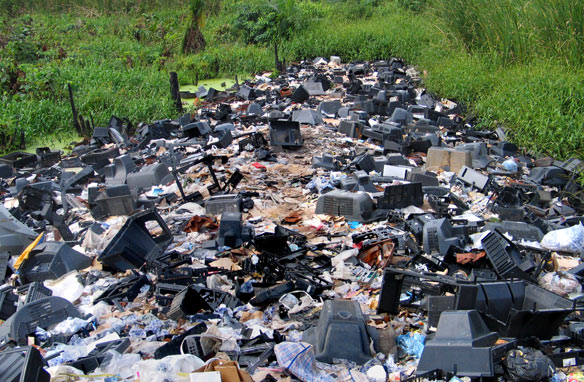
Some 50 million tones of hazardous e-waste, various electronics that have long met their life cycle and now need to be disposed, are being generated each year. The figure has risen dramatically compared to previous years and will continue to do so in the future as well, in part because manufacturers have constantly lowered their product’s life cycles, from five years on average to two years on average, for increased profits. With this in mind, the issue is far from being new, what’s clear is that people, and especially governments and major electronics manufacturers, need to be reminded of this great peril some parts of the world might be facing. A major reminder came recently at the CleanUp 2013 conference in Melbourne, where Professor Ming Wong, director of the Croucher Institute for Environmental Sciences, at the Hong Kong Baptist University, held a keynote.
“I would call it a global time bomb,” says Wong, referring to the growing pile of waste produced by old mobile phones, computers and other electronic devices.
“[It] is the world’s fastest growing waste stream, rising by 3 to 5 per cent every year, due to the decreased lifespan of the average computer from six years to two,” says Wong.
“In countries such as Australia the disposal of e-waste in landfills generates a potent leachate, which has high concentrations of flame retardant chemicals and heavy metals. These can migrate through soils and groundwater and eventually reach people.”
Regarding Australia’s practice, this is actually the de facto method used by countries all over the world. According to the EPA, over four billion pounds of e-waste was discarded in the United States in 2005, accounting for between 2% and 4% of the municipal solid waste stream. As much as 87.5% of this was incinerated or dumped in landfills – none of these practices can be considered sustainable. Only about 12.5% of the total was recycled.
E-waste contains toxic materials such as lead, mercury, cadmium and brominated flame retardants. These materials are considered bio-accumulative, which means they concentrate in fatty tissues where they can have severe, negative impacts on fetal development and on nursing infants. It has been estimated that consumer electronics may be responsible for up to 40% of the lead found in landfills.
Often times, governments of developed countries wash their hands off and send their e-waste over to developing countries, where labor is cheaper and environmental laws are more permissive. Here, in parts of the world like Africa or Asia, precious metals that go into e-waste (gold, silver and platinum from microchips, motherboards etc.) are basically scavenged under precarious working conditions, leading to extensive pollution of air, water, food and people.
“The toxic chemicals generated through open burning of e-waste include PCDD, PBDEs, PAHs, PCBs and heavy metals,” says Wong. “[These] have given rise to serious environmental contamination.”
“Some of these toxic chemicals are known to build up in fish especially, which may then be traded locally and around the world.”
“At the same time these e-waste contaminated sites are extremely hard to clean up due to the complex chemical mixtures they contain,” he says.
“It is clear there is an urgent need to manage e-waste more efficiently in all countries and through better international collaboration … China is looking at this issue very seriously.”
At the conference, Wong proposed a series of solutions that basically can be summed up into a call for genuine joint responsibility between the world’s develop countries’ governments and major electronics manufacturers. For one, manufacturers need to make their electronics last longer and at the same time make it easier for key components to become reusable. Countries at their own term need to introduce legal policies that restrict the export of e-waste to less affluent states. “Countries should take responsibility for their own e-waste,” says Wong.






